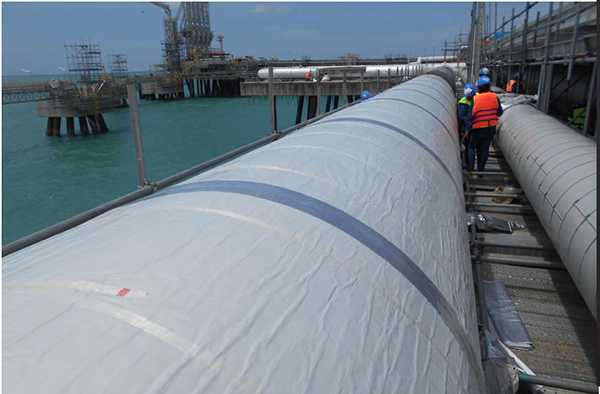Aerogel blankets have become a cutting-edge solution in thermal insulation, known for their ultra-low thermal conductivity, lightweight structure, and high temperature resistance. However, choosing the right aerogel blanket for your application requires a clear understanding of the specific project requirements and the product’s performance characteristics.
An aerogel blanket is a composite insulation material made by combining silica aerogel with reinforcing fibers (often fiberglass or polyester). This results in a flexible, robust, and highly efficient insulating layer used across multiple industries—from oil and gas to construction and aerospace.
Thermal conductivity is the most critical factor. Aerogel blankets typically have thermal conductivities as low as 0.012–0.020 W/m·K.
For high-temperature applications (e.g., pipelines, industrial ovens), select a blanket rated for 600°C or higher.
For cryogenic insulation (LNG storage, aerospace), verify that the blanket retains performance in extremely low temperatures.
High moisture or humidity: Choose a hydrophobic aerogel blanket to prevent performance degradation due to water absorption.
Chemical exposure: Ensure the blanket is chemically resistant if used in refineries, chemical plants, or battery packs.
Fire resistance: Opt for a non-combustible product that complies with fire safety standards such as ASTM E84 or EN13501-1.
Thinner aerogel blankets (e.g., 5 mm or 10 mm) are ideal for tight spaces while still offering high insulation value.
Higher density blankets provide better mechanical strength and thermal resistance, but may be less flexible.
Applications requiring flexibility (e.g., curved surfaces, valves) should use lower-density or reinforced versions for easier installation.
Choose reinforced blankets (fiberglass or polyester-reinforced) if the material needs to resist compression, vibration, or mechanical wear.
For applications needing regular removal and reinstallation (like valve or flange covers), ensure the material offers durability and flexibility.
Aerogel blankets are often easier to install than traditional rigid insulation, but confirm:
Cutability: The blanket can be cut cleanly to fit various geometries.
Wrapability: It conforms well to pipes, tanks, and complex surfaces.
Dust generation: Some blankets produce silica dust when cut. Select dust-reduced or encapsulated products for cleaner applications.
While aerogel blankets are more expensive upfront than traditional insulation, they offer long-term energy savings, space reduction, and maintenance advantages.
Analyze total cost of ownership (TCO) rather than just purchase cost, especially for energy-intensive or space-limited projects.
Industrial piping and equipment: Thermal insulation with minimal thickness.
Oil & gas pipelines: High-temperature and moisture-resistant insulation.
Building envelope insulation: Especially in historic buildings where space is limited.
Automotive and battery thermal management: Lightweight fire-resistant insulation.
Aerospace and cryogenics: Extreme temperature control in space-constrained systems.

| Property | Aerogel Blanket | Fiberglass | Mineral Wool (Rock Wool) | Calcium Silicate |
| Thermal Conductivity | ★ 0.012–0.020 W/m·K | 0.030–0.045 W/m·K | 0.035–0.050 W/m·K | 0.060–0.080 W/m·K |
| Max Temperature Resistance | ★ Up to 650°C (some up to 1000°C) | Up to 540°C | Up to 650°C | Up to 930°C |
| Thickness Required | ★ Very thin (5–10 mm) | Thicker layers needed | Moderate to thick | Thick (≥25 mm) |
| Weight | ★ Lightweight | Lightweight | Heavier than fiberglass | Heavy |
| Moisture Resistance | ★ Hydrophobic versions available | Poor (can absorb moisture) | Good moisture resistance | Poor moisture resistance |
| Fire Resistance | ★ Excellent (non-combustible) | Non-combustible | Non-combustible | Non-combustible |
| Mechanical Durability | Good with reinforcement | Moderate (easily compresses) | Good | Excellent |
| Flexibility | ★ Highly flexible | Flexible | Rigid to semi-rigid | Rigid |
| Ease of Installation | ★ Easy, cuttable, conformable | Easy | Moderate | Hard to shape and install |
| Dust Generation | Moderate (can be reduced) | Low | Low | High |
| Cost | $$$ High upfront cost | $ Low | $$ Medium | $$ Medium |
| Ideal For | Space-limited, high-efficiency, critical thermal control | Residential, HVAC | Industrial, acoustic + thermal | High-temp pipelines, vessels |
Aerogel blankets offer superior thermal performance, especially where space savings and extreme heat resistance are crucial.
Fiberglass and mineral wool are cost-effective for general-purpose insulation but require more thickness.
Calcium silicate excels in high-temperature, structural applications but lacks flexibility.
Choosing the right aerogel blanket involves more than just picking the most thermally efficient product. You need to align the blanket’s thermal rating, mechanical strength, environmental resistance, and installation flexibility with your specific application needs. Whether you’re insulating high-temperature equipment or managing space-critical installations, aerogel blankets offer a high-performance, modern solution—when chosen wisely.